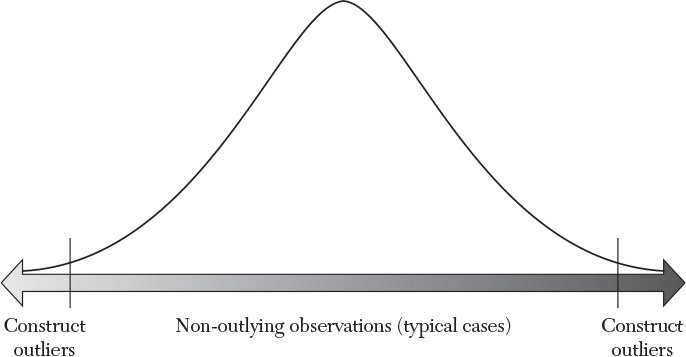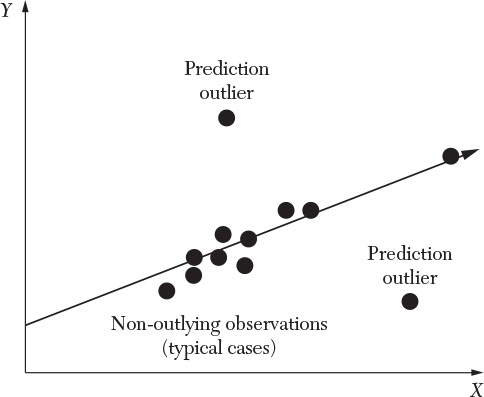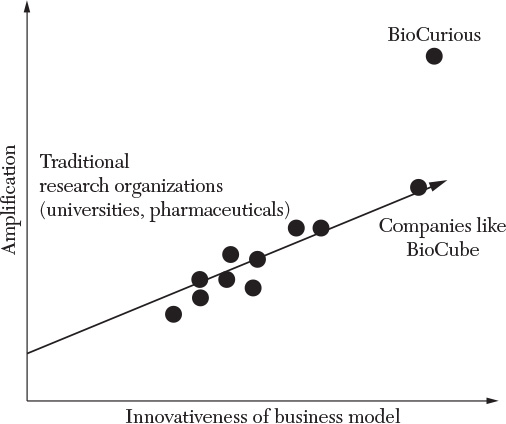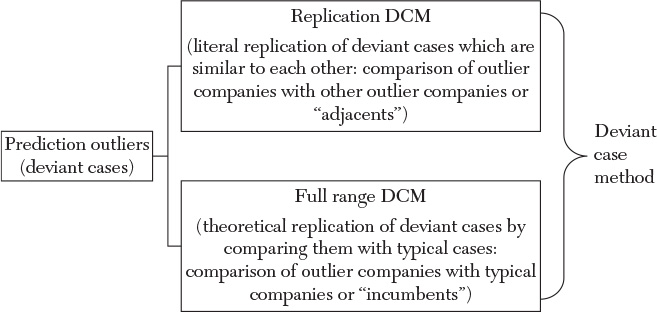2. Outliers from a Theoretical and Methodological Perspective
Before we introduce the cases, allow us two brief vignettes on the more scientific and technical aspects of outliers. In particular, we describe the methodology and logic behind different types of outliers. If you are not interested in research methodology and the academe of outliers, simply skip the following section.
Outliers from a Theoretical Perspective
Outliers are intuitively interesting organizations from a theoretical perspective in that they both challenge and build upon existing knowledge structures (Murray and O’Mahoney, 2007; Bogers and West, 2012). However, in academic research it is unclear how these outside or fringe sources of knowledge interact with other organizations in order to achieve the major impact they have the potential for. Outliers—whether individuals, movements, or companies—are a potential source of new practices and knowledge. Due to this very difference that defines them, outliers (cf. Hill and Rothaermel, 2003) are credited with being able to disrupt technology, innovate business models, rethink organizational structures, and cross industry boundaries. While often small in size or short on history, such outliers may embody big ideas (Välikangas and Sevón, 2010), and hence exercise more influence than their often humble, or occasionally brash, appearance would at first suggest.
However, outside of the realm of technological innovation and competitive dynamics, the interaction between outliers and incumbents is less well understood, particularly from a knowledge creation and transfer perspective (e.g., Lyytinen and Damsgaard, 2001; Birkinshaw et al, 2008; Abrahamson, 1991; Carlile and Lakhami, 2011). Even within an industry the conditions that enable an innovator to build upon the work of others are not fully understood (Murray and O’Mahoney, 2007). As innovators often rise out of very different types of organizations and contexts (Owen-Smith and Powell, 2003; Padgett and Powell, 2012; Schumpeter, 1942), it is unclear how some, of the many, outliers acting on, and beyond, the fringes of industries manage to leverage their difference to drive system-wide change (cf. Andriani and McKelvey, 2009)—after all difference in and of itself does not equal voice or impact.
As a basis for our empirical research we first assess how outliers have been treated by the strategic management literature, a field with a stated goal of explaining difference and heterogeneity (Felin and Foss, 2004), through an analysis of the scholarship. After noting the implications of omitting outliers we suggest how strategic management research could develop methods and concepts by which to better understand the mechanisms of knowledge creation and transfer.
Outliers and Management Research
We note, in line with Hawkins (1980), that outliers are a potentially heterogeneous subgroup relative to a larger group of mainstream organizations. They can even deviate so much from the other observations as to arouse suspicion that they were generated by a different mechanism. They are noted as potentially important by definition, and their practices make up a significantly different subgroup from the rest of the population (Massini et al, 2005). These subgroups of outlier organizations are not often far from permanent. Instead, such difference in environments and systems has been found to suffer from a regression to the mean (Upton and Cook, 2006) whereby even once exceptional organizations become increasingly average over time. Thus, this difference should be recognized in strategic management research while it exists as firm heterogeneity has been described as the very raison d’être of strategic management, and thus contributes to the very essence of competitive advantage (Felin and Foss, 2004).
We conducted a keyword search for “outliers” in the complete electronic archives of a number of the leading management research journals that exhibit empirical studies. Our analysis yielded 198 articles that showed that 74 percent of the studies noted the presence of outliers in their data yet proceeded to utilize methods by which to eliminate or control outliers with the objective of cleaning up the dataset or simply “to keep the graph nicely scaled” (Fuentelsaz et al, 2012). Established methods, including winsorizing the top and bottom of datasets are regularly evoked. Regressions are conducted in order to “counter the bias introduced by potential outliers . . .” (Roper et al, 2008) and justify the manipulation of datasets. (See the U.S. Commerce Department’s National Institute for Standards and Technology Statistics handbook for a full discussion.)
While outliers were summarily dismissed in most articles in the sample our analysis showed that 17 percent of studies still noted the presence and significance of outliers as indicative or something potentially more than an error term. For example, Fagerberg and Srholec recognized that “[s]imply excluding the outliers from the sample may not be the best solution, as we then may lose important evidence” or that they “do not want to dismiss [data points] as outliers, but on the contrary we believe it would be worthwhile to study them in some detail” (2008). Indeed, of the analyzed articles that recognized outliers in the first place, only 8 percent explained, or sought to explain, why outliers were present or what they may signify.
This is not surprising, given the fact that other studies in management and organizational science have also noted that the potential of outliers is vastly neglected. The study by Gibbert, Nair, Weiss, and Hoegl (2014) identifies that during two decades (1993–2012), only 318 papers (less than 5 percent of the papers published in the top six Management journals1) explicitly reported the detection of outliers. Of these 318 papers, only six papers actually perused a further examination of the deviant cases, and only two of them moved on to actual deviant case analysis.
1Strategic Management Journal, Academy of Management Journal, Administrative Science Quarterly, Journal of Management, Organization Science, Management Science and Research Policy.
With the noted exceptions, our analysis of the strategic management literature found that most studies did not consider the different explanatory mechanisms, or the potential knowledge they may signal, that caused outliers to be found in datasets. Together with other researchers (such as Daft and Lewin, 1990; Siggelkow, 2007) we are concerned about the methodological sleight of hand that leaves outliers out of studies. Being very different points to a knowledge source that, by the researcher’s methodological choice, is left unstudied. We argue that sweeping potentially important knowledge under the proverbial carpet of data-model fit is unlikely to drive progress in management research or practice. This is noteworthy, we feel: As according to Karl Popper, scientific progress comes directly from observations that do not fit expectations. Finding that one black swan in a sample collected on the presumption (a.k.a. hypothesis) that all swans are white raises a lot of questions about reasons for this dismissed “unexplained noise” as methodologists prefer to call it.
With this book, we try to show that this unwelcome “noise” in the data can actually be turned into novel questions in the hands of an intellectually curious and methodologically informed researcher. Why is this swan black? Is it actually a swan? Were all the white creatures we believed to be swans perhaps just large seagulls? What makes us see things in black and white in the first place? What else is out there? Where are the other colors?
Toward an Outlier Inclusive Understanding of Knowledge
In order to both understand the conditions under which such very different knowledge can be developed and transferred, the study of outliers must be reconceptualized from a framework where they are simply error terms that do not fit the mean to research on knowledge that can potentially change the mean, redistribute the curve, or establish a new normal (Paukku and Välikangas, 2012). While there are outliers that arise due to measurement or data collection error we argue for the study of the other type of outliers. These are the “interesting outliers” (Aguinis et al, 2013), which hold immense potential for constructive and in-depth understanding of empirical phenomenon (Gibbert et al, 2014). Such outliers are often characterized as the frontrunners of business model innovation, the first adopters of breakthrough technologies and manifestations of future trends (see e.g., www.iftf.org). However, the myriad versions of the future suggested by these frontrunners do not represent the leading edge of a predetermined linear future. Instead the variation they bring about presents real or additional options of next practices, business models, and technologies.
Thus we argue that outliers represent alternative, often competing technologies, knowledge perspectives, or trajectories and challenging models, organizations, and knowledge bases. Difference can, of course, mean failure as well as success (March et al, 1991). Yet omitting outliers comes at a great cost to the comprehensiveness of research (Siggelkow, 2007; Daft and Lewin, 1990; McKelvey and Adriani, 2005). Understanding industry transitions and systemic change requires a study of all of the deviating organizations that, despite, and especially due to their low probability and distance from the mean, may have an impact on the system. We suggest that by reframing the scope of enquiry to include outliers may provoke some interesting theoretical and empirical research findings of the mechanisms by which novelty is created and transferred.
What is the significance of outliers and the novelty they bring to a population? Strategic novelty brought about by outliers can introduce or renew existing practices within an industry. The ideas generated by outliers drive the boundaries by which mainstream organizations eventually perceive, acquire, and process knowledge, and subsequently, process the world. Outliers experiment with business models in various contexts, blurring boundaries and generating more diversity, making the overall system more resilient. For example, the non-profit sector, led by such organizations as the Bill and Melinda Gates Foundation, has for long adapted best practices from business. Today, some of these organizations are cited as sources of innovation for business organizations tackling complex or wicked problems. In the study of systems, instances of such positive deviance have proved vital when the “positively deviant” have survived otherwise failing systems or when their knowledge has been leveraged to find local solutions to global complex problems (Pascale et al, 2010).
The delineation between the creation of knowledge and the transfer thereof becomes blurred. For innovation to occur, ideas must be widely accessible (Murray and O’Mahoney, 2007) yet different at the same time. We posit that often it is these interactions and knowledge creation and transfer mechanisms that occasionally drive transformation achieving far reaching, and outsized impact. In line with this framing of outliers and incumbents that we seek to understand the mechanisms that can move the goalposts—delimit the context, drive transformational change, and create and transfer knowledge from the margins to the mainstream.
Outliers from a Methodological Perspective
To understand differences between different types of outliers, let’s start by looking at a number of recent topical books.
Malcolm Gladwell’s New York Time’s best seller “Outliers: The Story of Success” comes to mind first. The author picks various persons as outliers and examines the factors that contribute to their outstanding success. Other authors, have looked at outliers, too, albeit less explicitly. For instance, W. Chan Kim and Renée Mauborgne (“Blue Ocean Strategy: How to Create Uncontested Market Space and Make Competition Irrelevant”) and James C. Collins (“Good to Great: Why Some Companies Make the Leap . . . and Others Don’t”) have investigated outlier companies and the complex phenomena contributing to their success. Kim and Mauborgne examined companies such as Cirque du Soleil, which succeeded by creating new, unchallenged, uncontested market space, also known as “Blue Oceans,” instead of competing in an established market. Collins studied outlier companies that evolved sustainably from “good” to “great” (above average) in terms of financial performance. However, a follow-up analysis of the same set of companies showed that later they actually underperformed the S&P 500. Steven Levitt, author of Freakonomics, suggested that a backward-looking, historic analysis of the reasons for success of outstanding performers would not be helpful in providing principles for future success. Professor Rita McGrath, on the other hand, studied outliers that achieved steady growth for 10 consecutive years. She found a small set of 10 companies out of a sample of 5000 publicly traded firms listed on stock exchanges with market capitalization of over 1 billion USD. The 10 companies are very different from the others, though they shared certain common traits combining stability with dynamism, which McGrath identified and explained.
It would appear that the common denominator underlying these studies is their direct focus on higher-than-average performance, success, and competitive advantage, typically measured in stock price or growth rate in comparison to industry peers or market average over a specific period of time. To be sure, there is nothing wrong with extremely good performance, understanding where it comes from, and how it can be replicated. However, this book, and in particular its cases, deviate from this route. We believe that there are expiry dates to the strategies that support these cases of superb performance. Even the most compelling strategy decays over time. Therefore novelty, and the business models that can push the next great performance frontier, might be worth investigating.
Outliers Versus Deviant Case: Why Extreme Performance Isn’t Enough
What differentiates the present study from other similar studies is the type of outliers we focus on. Rather than using performance as a measure to sample and select outliers, we searched for deviant companies that depart significantly from established industry practices. What makes deviant cases different from performance-based outliers?
A recent study by Aguinis and colleagues (2013) suggested a three-pronged classification of outliers: construct outliers, model-fit outliers, and prediction outliers. Construct outliers are the outliers that display extreme values on a variable of interest (dependent or independent variable/X or Y), for instance, the small number of people who are exceptionally tall relative to the rest of the population. Model-fit outliers, meanwhile, are observations with extreme values on the predictor variable, and correspondingly extreme values on the outcome. That is, they are observations that have an independent variable or causal condition similar to the typical cases, but have an extreme value on the dependent variable (same X, extreme Y). For instance, if we assume that a theoretical model predicts that tall parents have tall children, we may observe an outlier case in which exceptionally tall parents’ children are exceptionally tall (X-height of parents, Y-height of children). Then we come to the final type of outliers, the prediction outliers. These outliers have large, so-called model residuals (only), or large model residuals in addition to having extreme values on the focal variables (similar to model-fit outliers underlying the infatuation with extreme performance we discussed earlier). In simple terms, these are outliers that are significantly “different,” i.e., they deviate from the existing phenomenon of interest. They are not (just) extreme values, they are (also) deviant (same X, different Y or same X, different and extreme Y). Keeping with the previous examples, prediction outliers would be cases of people who have tall or extremely tall parents, but are quite short themselves (or are very tall despite having short parents). Thus, the “residuals” in the model are the (unconsidered or unknown) factors that cause unexpectedly (from the perspective of the theoretical model) short body height, despite the tall parents. Figures 2.1 to 2.3 illustrate these three types of outliers.
In terms of this classification, then, Gladwell focuses on construct outliers, whereas Kim and Mauborgne, and Collins study model-fit outliers. In fact, most of the outlier books of the last four decades invariably focus on extreme performance, and try to explain what brought it about. By contrast, we focus on prediction outliers, i.e., outlier companies which deviate from the industry norms with their uncharacteristic business models and, despite their different approach and a dearth of the assumed requisite relative resources and experience, are able to be impactful. In short, these cases have large “residuals,” i.e., differ in amplification with performance implications. Figure 2.4 shows one such example. In this example, the company “BioCurious” is the prediction outlier with a highly innovative business model. The typical cases in this case’s field are the incumbents, i.e., traditional university research centers and pharmaceutical companies. The main factor that sets BioCurious apart from its incumbents is its open and inclusive model. Unlike traditional companies, BioCurious makes science accessible and affordable to all. BioCurious calls them citizen scientists. It allows diverse people to engage with biotech for a range of purposes and goals, such as experimenting to improve one’s work performance, and thus not only pursue academic or corporate biotech objectives.
We believe that an analysis of these prediction outlier companies may shed new light on the inconsistencies emerging whilst trying to reconcile theoretical predictions (industry norms) with real-world observations (Lieberson, 1992). By pointing out a new causal factor (uncharacteristic business model), which has been so far neglected, the analysis of these companies could actually improve the correspondence between what we knew so far (industry norms) and what we now observe (strategic novelty).
Sampling Approach and Research Design
How did we find the outlier companies? We identified broad fields currently undergoing major transformations, in particular due to unique combinations arising from the use of digital technologies and open collaborative practices. It appealed to us that digitization and inclusiveness were major drivers of potential transformation. So, we looked out for outliers in industries and competitive spaces where these drivers were making a unique impact. Despite this systematic method for hunting outliers and their strategic novelty, we tried wherever possible to practice what we preach by being consciously open to serendipitous discoveries and surprise. We found companies like BUG through this openness.
Our mind-set was one of discovery, so we cast a wide net in an effort to search for any company that did not fit norms and/or deviated from what could be loosely termed its peers. We followed a research method akin to grounded theory (Strauss and Corbin, 1990), a systematic discovery-driven method that is suited for exploratory research of phenomena that have been understudied. Thus, for over 3 years we followed closely printed and digital media (publications and blogs) in the fields of business, technology, and entrepreneurship. True to the grounded theory approach, we used a variety of sources, from interviews, archival data, and even participant observation, triangulating wherever possible and relevant the various sources as a means for ensuring the construct validity of our findings. Analysis involved travelling back and forth between data and emerging propositions (with the occasional surprise in between). We also used respondent validation, e.g., by sending emerging and final drafts of the cases to the founders to elicit feedback and commentary. We also extensively draw on external commentary (published in this book) by industry and academic experts both as a kind of peer-review valuation as well as a source of insights in its own right (procured commentaries are published with the cases). We were on high alert looking to uncover novelty at conferences, meetings, and workshops. From several discussions, we followed leads that snowballed into new conversations. In addition, we created opportunities to engage in discussions about outliers with researchers and industry leaders as well. We discussed outliers in the Opening Plenary of the Strategic Management Society’s Lake Geneva Conference and presented some company examples, together with their leaders, to the Global Drucker Forum in Wien in 2013. We engaged in a “Talkoot” workshop on non-profit outliers with the Institute for the Future in Palo Alto, California, in 2012 (http://www.iftf.org/future-now/article-detail/at-talkoot-small-makes-for-big-changes-in-the-future/). Throughout this period, we stored and organized, in a systematic way, data collected from company materials and notes from observations and discussions so that we were able to continuously analyze the growing set of data and point to potential cases of novelty. Finally, we considered companies which deviate from incumbent companies in the same arena and demonstrated the ability to create business models that amplify their impact, either by transforming existing strategies or by creating whole new strategies. Despite all this, we have still missed many outliers worth noting and must limit ourselves to the edition presented here.
The majority of the cases we have selected utilize open business models or models, which are more open or inclusive than the industry norm. Many of these involve crowdsourcing (via cloud labor, crowdfunding, crowd-creativity, collective intelligence, co-creation, open innovation, micro-tasking, crowd-contests, etc.). These companies have found ways to address either some unmet customer needs (e.g., Scoopshot, Gengo), new needs (e.g., Kaggle) or unarticulated needs (e.g., BioCurious, Spire), or existing needs through novel means (e.g., Grow VC Group). They use digital technologies in novel ways to accommodate participation and make contribution modular and as easy as possible. They build inviting architectures for contribution that appeal to their target group.
Overall, our goal was to make the outliers’ amplification strategies more visible, tangible, and perhaps even replicable. Augier, March, and Marshall (2015) revealed that the creation of the infamously productive RAND Corporation was perceived by some as a “happy accident.” Following their in-depth study of the history of RAND, they came to the conclusion that such ventures are unpredictable in their emergence, broadly impactful and distinctive only for a short period of time. (For readers who are interested in studying our outlier companies further deeply, please refer to Box 2.1.)
So why study outliers if they are rare and short-lived? The relevance of the outliers we present in this book lies precisely in this very currency. The insights their business models offer have potential beyond the companies themselves. As we discussed in the introduction, appreciating strategic novelty comes at the price of openness to risk and uncertainty. Companies who have already proven their success (even extreme success) are no longer novel in the strategic sense that this book espouses. As their distinctiveness might be short-lived, and even if they persist they are hard to imitate, studying outliers becomes a unique opportunity to tease out potentially transformative yet fleeting strategies. However, we stress the point that this study is not by any means an exhaustive study of all the outlier companies in a particular area. Rather, it is a hopefully eye-opening “fishing trip” to find novelty in deviance—to explore novelty that can expand the boundaries of our current thinking about strategic innovation.





